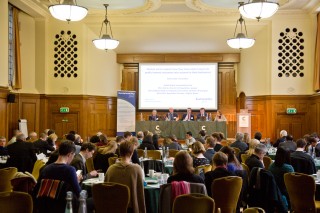Francesca Moll explains why an active demand side is the key to unlocking some of the greatest challenges in the energy and water sectors.
Lawns paved over. Cars going unwashed. Sirens in public showers.
This is everyday life for ordinary people in drought-stricken Cape Town, South Africa. The city has been experiencing the worst drought in 100 years, and will shortly approach a ‘day zero’ where the majority of the city’s water supply is shut off and water rationed through collection points around the city. This gives us an early foretaste of the formidable environmental challenges energy and water may face in the coming years.
Pippa Malherbe, resident of Cape Town suburb Somerset West, is one of the many South Africans who have had to adapt to the city’s new normal. She has installed a host of water efficiency measures in her home to help her and her family keep within the allowance of 50 litres a day per person.
She has pipes to collect used water and runoff from her shower, gutters and washing machine, which is used to water her garden and flush toilet cisterns. She reports not using municipal water for this purpose for over a year. Rather than shower every day, Pippa and her husband bathe in their pool, which they keep topped up with water they buy from those lucky enough to have access to boreholes.
Before we create the energy and water systems of the future, we have to ensure we’re all on the same page. That’s why the New Energy and Water Public Interest Network - New-Pin’s -consensus-building work is so vital. In this blog, Francesca Moll and Sharon Darcy explain what we’ve been doing.
How do we hear the public interest voice in the energy and water sectors? It isn’t always easy to have a constructive discussion.
Rightly or wrongly there is a feeling that voices of ‘ordinary people’ remain unheard at the heart of the energy and water industries. Companies faced with this charge may see things through another lens; how best to meet the challenges of climate, socio-demographic and technological change whilst operating under an intense political spotlight and delivering a significant amount of policy and regulatory change. Government and regulators may have a different perspective again, often focussed on the need to address short-term affordability pressures within electoral and regulatory cycles.
Given such divergence, how do we find a way forward? What does fairness look like? Who is responsible? And how do we ensure we’re future-proofing our energy and water systems so that they continue to serve majority needs in the future? Fairness, after all, is relevant not only within generations but also between generations.
These questions have never been more vital. Energy and water face huge upheaval. With the technological revolution represented by digitisation and the smart energy meter rollout, a polarised political mood, the need to prepare for a low carbon future and the risks represented by climate change, it is clear that the stakes are high.
Sharon Darcy summarises the latest New Energy and Water Public Interest Network (New-Pin) thinking on innovation.
Innovation is a hot topic. In this period of significant economic, social and political uncertainty, and powered by big data and new technologies, experimenting with new ways of doing things is in itself becoming the ‘new normal’ in many walks of life.
The energy and water sectors are not exempt from this change. External and often global threats, driven by digitisation and evolving customer expectations but also demographic and climate change, means that the counter-factual to many new ideas is not necessarily the status quo. To provide short and long-term affordability and resilience, new ways of doing things may be needed.
Innovation in energy and water poses some specific challenges. Markets can help innovate in many areas in the sectors. However, even markets need frameworks and rules. On their own, markets are also unlikely to innovate around certain desirable public interest outcomes, including long-term resilience, fairness and place. And when there are monopoly activities, and / or imperfect competition, as is frequently the case in energy and water, the extent of innovation may be limited.
Government and regulators have a difficult tightrope to walk here. Innovation is not an end in itself and is frequently a journey of discovery. Keeping out of the way may allow ideas to flourish but these may not meet public interest outcomes. Intervene too early or too generously and accusations may follow of picking winners or actually creating new barriers to doing things differently.
Future success for an energy or water company depends on the board’s firm grasp of consumer and wider stakeholder requirements today – and a clear future view of how those needs are changing given more flexible, responsive and decentralized models of service delivery.
Sharon Darcy shares the key conclusions from Sustainability First’s latest review of how energy and water companies bring the long-term public interest to the board table. Part of our New-Pin programme, this work draws on interviews with 26 senior colleagues in the energy and water sectors. It includes a ten-point check-list specifically designed for energy and water companies to assess how effective their board is in meeting future customer and wider stakeholder needs.
Corporate governance is very much a live issue across the economy. Twenty-five years after Cadbury, there is growing concern that many UK companies still give too much weight to short-term interests. Current approaches to board effectiveness are also being disrupted by wider societal change. Diminishing trust in business in general, and the particular complexities this poses for regulated sectors, adds to this challenge.
Change is afoot. The Financial Reporting Council is carrying out a fundamental review of the Corporate Governance Code and updating their board effectiveness guidance. In August, BEIS promised secondary legislation regarding Section 172 of the UK Companies Act. For some time, Section 172 has provided a lever for listed companies to address wider stakeholder needs and focus the business on long-term stewardship. The proposed changes will increase the pressure on all large companies to review their corporate governance arrangements and ask how effective they are in delivering wider stakeholder outcomes.
These issues clearly have a particular resonance in energy and water where companies deliver essential services and are stewards of critical infrastructure. A focus at board level on meeting future customer and wider stakeholder needs, including those of the environment, is therefore vital.
Stine Wilhelmsen, Common Vision Energy and Water Millennial Working Group What will citizens need and want from future energy and water systems, and what changes are required for their expectations to be met?
This heading set the scene for ‘Tomorrow’s World’ - a one day workshop jointly led by Sustainability First and the National Infrastructure Commission – in which the speakers did their best to set the scene despite the plethora of known unknown clouding the horizon. What will the regulatory landscape look like post-Brexit? In what ways will smart technology continue to revolutionize the utilities industry? How will climate change impact our water and energy security?
When Common Vision invited me to come along to the workshop I was intrigued by the opportunity to hear how representatives from the water and energy sector, regulators, and organisations representing rural communities, low-income households, and the older generation viewed future opportunities and challenges.
Minutes into the first panel, I was struck by the fact that there’s no one-size-fits-all solution for future energy and water demands. People will continue to need and want different things, depending on where and how they live. Whereas millennials growing up in the digital era might get excited about the premise of smart technology controlling their heating, a pensioner could get equally worried about the demise of familiar services. To avoid leaving anyone behind the water and energy industry needs to provide affordable, tailored solutions for all pockets of society.
Generation rent This rings equally true for initiatives aiming at engaging people in reducing water and energy consumption - a vital aspect of meeting carbon emissions targets. Campaigns encouraging people to invest in energy and water efficiency measures such as insulation is likely to fall flat on an audience of Generation Rent-ers used to moving house every 6 – 12 months.
Rachel Taylor, Common Vision What do customers and citizens need and want from future energy and water systems, and what changes are required for their expectations to be met? This was the topic of an event hosted by Sustainability first and the National Infrastructure Commission in July 2017, for which Common Vision convened a “millennial working group” to participate.
To ensure that we are able to continue using energy and water which meets our evolving needs and requires minimal lifestyle changes by 2030, we must begin enacting change now. These sustainable alternatives must take into account the challenges posed population growth, an aging population and climate change – to name a few examples.
Our energy and water systems provide us with the essentials we use and need in our everyday lives, from powering our mobile phones and heating to our showers, baths and drinking water. The provision of energy and water affects all groups in society regardless of background, income or age bracket yet, different groups do have different needs; all of which must be addressed when designing our plan for the future.
For low-income groups, the so-called ‘poverty premium’ is a major concern whereby the poorest in our society often end up paying more than higher-income households for essential goods and services. It is not surprising then that the primary needs for low-income groups were affordability and tariff consistency. Organisations such as the Joseph Rowntree Foundation have been active in this area, calling on the government to do more to help identify and tackle poverty premiums where they arise, especially in light of forecasted inflation. The elderly, as well as those living in rural areas across the UK, have in some cases also fallen victim to the poverty premium if, for example, they are not online and lack the means to acquire the information which would help them explore cheaper or greener options. This clearly demonstrated the need for better information provision, both online and offline, for these affected groups.
As well as this, the increasing life expectancy of the elderly population in the UK is indeed a cause for celebration but it also brings challenges which require us to ensure our future world is adaptable to the physical and mental ailments of this group. We must also not forget that those living in the countryside are the ones often subjected to the impact of new infrastructure developments which need its extra space. It is therefore important to listen to the insights and needs of this group in designing non-intrusive alternatives for the future.
Sustainability First organised a memorial lecture on 17 July 2017 In memory of Gill Owen. The lecture was given by Prof Martin Cave OBE, a former Warwick Business School colleague of Gill. Martin’s very fitting, and highly topical, lecture subject was ‘Distributional and Competition Aspects of Energy Pricing’.
Starting from the essential nature of energy for households, the fact that energy accounts for a larger proportion of expenditure for poorer than for richer households and the estimate of detriment identified in the recent CMA investigation, he described a methodology for approaching distributional fairness. He then went on to consider how innovation and smart meters could help vulnerable customers and to discuss responses to the CMA investigation, including proposals for demand-side remedies and price caps.
An internationally renowned economist, Martin specialises in competition law and the regulation of network industries, especially the communications sector. He is currently a visiting professor at Imperial College Business School and is also a member of the UK Competition and Markets Authority.
As many people commented at the event, the topic would have been close to Gill’s heart and she would have enjoyed immensely debating the issues with Martin.
Sarah Harrison, a Sustainability First Trustee and former Senior Partner at Ofgem responded to the lecture.
Sustainability First’s New Energy and Water Public Interest Network (New-Pin) has been exploring how far market-led approaches can deliver our desired long-term public interest outcomes in energy and water. Sharon Darcy shares some of the thinking from the recent New-Pin workshop on this topic. Although energy and water are at different ‘moments’ in terms of their experience with markets, many of the lessons from the workshop are generic across the sectors.
Markets can deliver many benefits – they can reveal new information and bring in new skills and partners leading to innovation, efficiency, and more responsive and flexible services. However, they are not risk free. Markets by their very nature create winners and losers; whether this is individuals (who may or may not be vulnerable) who are expensive to serve and therefore less likely to be targeted by marketing departments or companies that in a dynamic competitive environment may quickly find themselves with stranded assets.
The New-Pin Network has identified six possible desired long-term public interest outcomes for the energy and water sectors: value for money; quality services; cleanliness; resilience; ‘place;’ and fairness. Market-led approaches can deliver against most of these outcomes but not necessarily all of them. And even when they can be beneficial, in these sectors, along with many others, they need clear frameworks and rules if their effectiveness is to maximised.
Working out how to capture the beneficial ‘magic’ of markets whilst also being prepared for the potential pitfalls requires clear thinking and careful communication. Given the fact that markets are unlikely to emerge spontaneously in these sectors, and will require some degree of oversight and planning, it is clearly important that market-led approaches are focused where there is a need, and opportunity, to do things differently. Being clear about whether there is a case for change (such as new technologies coming on stream), and if there is consensus that there is a problem and what the possible solution is, is a first step.
Focusing market-led approaches where the net benefits are greatest is also important. Although markets can have beneficial ‘trickle down’ and indeed ‘trickle up’ impacts, and can drive wider behaviour change across the sectors, not all ‘knock-on’ impacts will necessarily be beneficial. And introducing market-led approaches can be tremendously time-consuming. There is likely to be an opportunity cost involved. Paying heed to where the greatest costs in the sectors lie would seem sensible when deciding where to target activity.
Thursday’s backbench Commons debate on energy prices has prompted politicians and others to consider a number of possible alternatives to the remedies made by the Competition and Markets Authority (CMA), following their investigation last year into electricity and gas prices. Around 70% of domestic energy customers remain on energy companies’ Standard Variable tariffs (SVTs) and could save up to £200 by switching to a cheaper deal, but nevertheless decline to switch.
In a new Sustainability First paper, I have argued that any potential solution to customer ‘stickiness’ needs to be measured against two key objectives designed to ensure that any remedy adopted is fair to all customers. My two ‘tests’ are: (1) that the arrangements encourage companies to price competitively and to innovate to meet the changing needs of the market, and also (2) that they avoid particularly unfair pricing for any domestic customer or group of customers.
The CMA remedies broadly deliver on the first of my two objectives by removing some previous barriers to increased tariff innovation. But the CMA only delivers on the second to the limited extent of providing protection through a price cap to customers on prepayment meters. For the roughly 50% of households that are able to engage in principle - but for whatever reason choose not to - the main CMA remedy is to provide those customers with more information about energy pricing and switching. The CMA does not seem to have looked across to thinking from the Financial Conduct Authority, who recently said, in its Future Mission Statement: ‘Public policy makers have traditionally assumed that people will make the ‘right’ choice for their needs if they are given as much information as possible… Our own research has also shown that that too much information can confuse consumers’.
Customers are being encouraged by the Government and regulators to become more engaged not just in their energy bills, but in choosing their retail bank and making financial provision for their retirement, to mention just two. But is this the right approach? Each of these activities takes time and effort, and many people will want a ‘good enough’ solution, not necessarily the absolute best. If people choose not to make the effort, does this mean we leave them to the consequences of their inaction, particularly where essential services are concerned? Or do we seek to avoid anyone being particularly unfairly treated or exploited? This is why both of my key objectives are important – both to encourage competitive pricing and to avoid unfairness.
None of the solutions proposed so far to tackle customer ‘stickiness’ – either by the CMA or others - fully meet my two objectives. One that seems to me to come closest, assuming there are no radical changes in current market arrangements, is in two parts. First, as proposed by Dieter Helm, energy suppliers offering an SVT should make public for scrutiny by customer watchdogs and other commentators the margin they anticipate making on it. This would seek to deter companies offering cheap deals to engaged customers at the expense of those on the SVT. Second, the evidence suggests that in reality many customers actually prefer an SVT and, if switching, would opt for their new supplier’s SVT. But, in contrast to switching to a 12-month fixed price deal, no price protection is afforded in moving to a new SVT. As we have seen in recent weeks, price increases by one energy company tend to be followed fairly quickly by the others. It is possible for a customer to get caught out by switching to a company that has not yet put up its price but is about to. In my paper, I therefore suggest that price comparison sites should also start to include the date on which the SVT was last changed. Although far from perfect, it may, by requiring transparent information on the last price increase, at the very least offer the consumer bodies some insight into whether a new price increase might be in the offing – and so might help confidence in the switching process. There are also lessons for the future. The Government’s plans for a new ‘smart’ energy world with smart meters and greater customer flexibility assumes that customers will respond to better information and greater price differentiation by changing their energy purchasing and usage patterns in response to time-of-use or other ‘smart’ tariffs. If the experience of stickiness in today’s domestic energy market is anything to go by, this could be a hard sell with many customers. More research is needed on the likely response of typical customers, and not just the enthusiastic minority.










